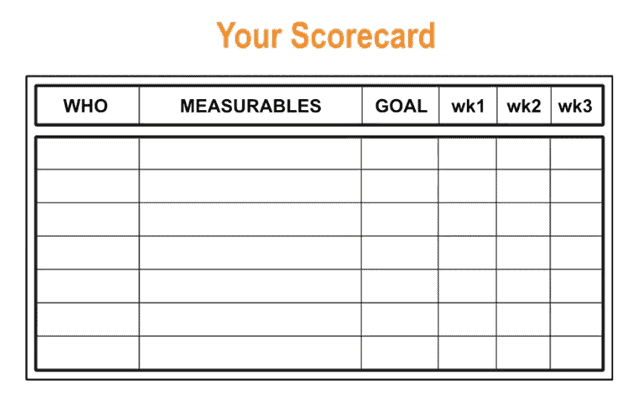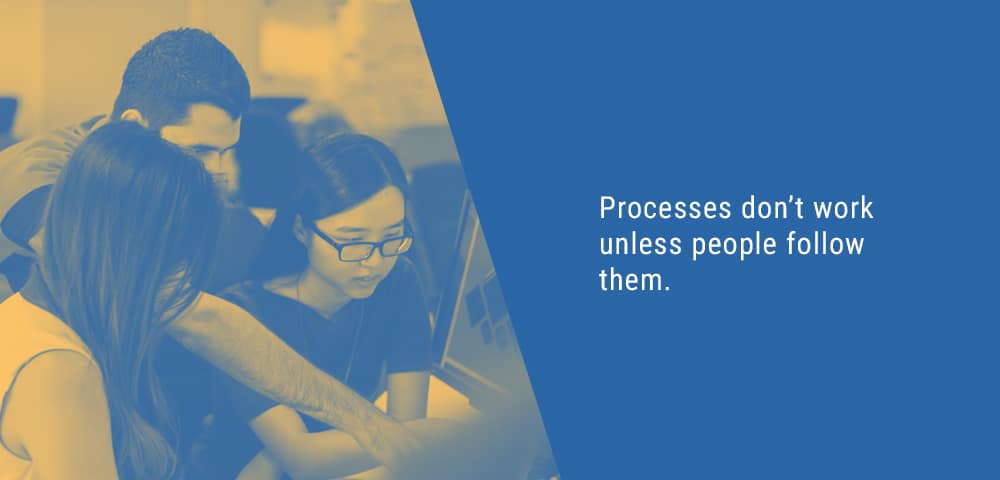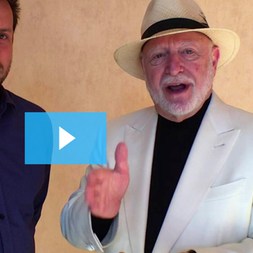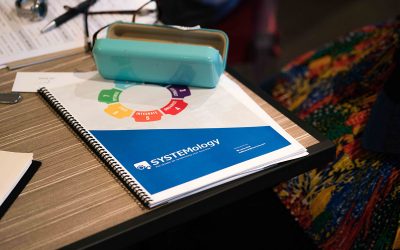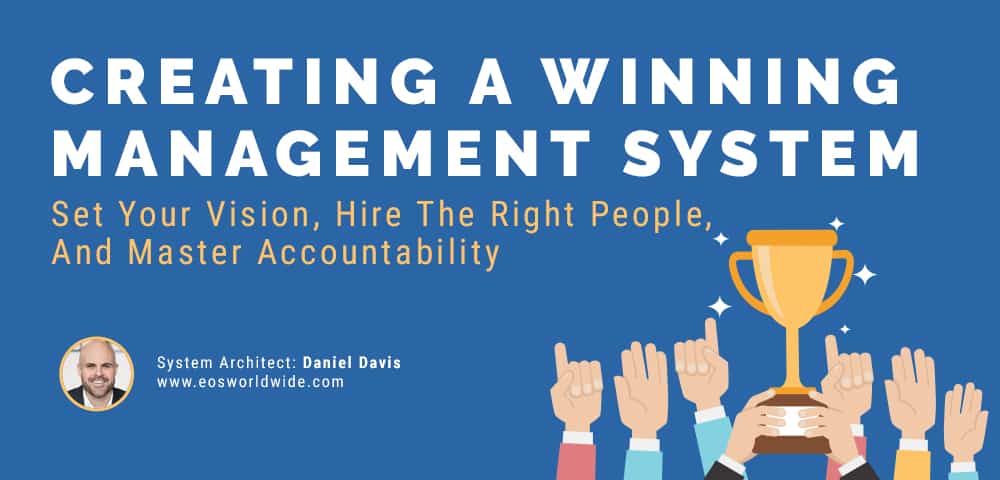
System Architect | Daniel Davis: www.eosworldwide.com
If you are an entrepreneur or small business owner, you’ll no doubt have come across some hurdles. Maybe you have a lack of control, problems with your staff, or are constantly frustrated that none of your processes seem to be working out. Without a proper management system in place, all of these obstacles can mean that your business is running you, rather than you running your business effectively.
As covered in his book “Traction”, Gino Wickman details a complete management process to strengthen the following Six Key Components of any business:
- Vision
- People
- Data
- Issues
- Process
- Traction
From start to finish, the steps detailed in the book go through all of the important things you need to do from the management and leadership level of your business. Gino Wickman talks about how to set your vision, how to hire and retain the right people for your business, dealing with issues and setting accountability.
If you don’t have time to read the book, don’t worry, as this article outlines all of the steps so that you can get on your way to creating a winning management system.
Management System Based on the Book ‘Traction‘: The Entrepreneurial Operating System (EOS)
Step 1: Vision – Clarifying and simplifying your vision so that everyone’s on the same page.
To get your business-plan-on-a-page, use the V/TO (Vision Traction Organiser) tool – ask yourself 8 questions:
1. What are your core values?
- Define what attributes, characteristics, and behaviours are important to you and your business. What is your DNA as a company?
2. What is our core focus?
- What is our purpose, cause or passion? What is our niche?
3. What is our 10-year target?
- Look ahead and ask yourself; where are we taking this? What’s the big picture here?
4. What is our Marketing Strategy?
- Define the basics, understand the fundamentals or your target market/ideal client. What is unique about our product or service? Why would a client do business with us instead of a competitor?
- What is our proven process, so we can show our clients how we engage with them and what to expect?
- Do we have a guarantee or brand promise?
5. What is the 3-year picture?
- What does it look like in your mind’s eye? What is our revenue and profit by then? What does the business look like?
6. What is the 1-year plan?
- What are the 3-7 key things we need to get done in order for us to achieve our 3-year picture?
7. What are our quarterly rocks?
- What are our company rocks – the 3-7 key things we need to get done this quarter to ensure we’re on track to achieve our 1-year goal?
8. What are our issues?
- What are the things you know you need to handle at some point, but you just don’t have the time?
Step 2: People – How to get the right people onboard and keep them onboard.
Ensure your team aligns with your values using The People Analyser tool (also use it as a recruiting tool).
- Insert your company values along the top of the chart and insert the names of your team members in the first column.
- Score each team member on each core value using a rating of a ‘+’ (mostly, yes), a ‘+ / –‘ (sometimes) or a ‘–‘ (mostly, no)
- Add a line called ‘The Bar’, some of your values may be non-negotiable, but some may not be make-or-break. Add your own scores to each of your values according to how important they are – set the bar (example below).
- Once you know you have the right people, it’s important to make sure you have them in the right position (The Right Seat). To do this, set up an Accountability Chart (see below).
- Firstly, define the core functions of your business – these are the ‘Seats’. Define some key responsibilities and functions for each role. Then you need to allocate a name against seat.
- Ask yourself; Do they “get” the role, do they “want” the role, do they have the “capacity” (skills) for the role? We call this “GWC”.
- Add those 3 columns to The People Analyser chart and add a Y or an N where applicable.
Note! A “no” is a deal breaker, there must be a “yes” for the person to be the right fit for their role.
Step 3: Data – How to measure the performance within the business.
To analyse whether you’re on track to reach your goals, create a simple scorecard.
- Create a list of weekly-tracked measurables for your business’ scorecard (e.g. weekly revenue, customer satisfaction, sales calls etc.). Ideally, you’ll get to the point where everyone in the organisation has a number.
- You can refer to this during meetings to quickly and easily determine what’s on track and what needs attention (if anything).
Step 4. Issues – Create a process to identify issues and system to fix them.
- Every organisation has “issues”; these can be problems, obstacles, or opportunities. The Issues List becomes a tool that creates discipline to keep all of your issues out in the open and organised in one place, and get you to solve them one at a time.
- Create an Issues Solving Track;
- Identify – First, identify the true root cause of the issue; it’s usually a few layers down. Only then can you come up with a solution for the cause and not the symptom, to ensure it goes away for good.
- Discuss – This step is the opportunity for everyone to have their say about the issue.
- Solve – Finally, conclude with the solution that resolves the issue t the root so that it goes away for good.
Step 5. Process – Document your core business processes to create consistency as you grow.
- Document the core processes of your business (people, marketing, operations, accounting etc. ) Start with the basics, document the 20% of the major steps in the process that produce 80% of the work/result.
- Ensure your processes and systems are “Followed By All”. Anybody in your organisation who touches these processes should be properly trained and know the right way of doing things.
Step 6. Traction – Bring the Vision down to the ground and execute on it with discipline and accountability.
- Rocks – set your key priorities for the next 90 days which will help you achieve the company’s 1-year strategic goals and keep you on track for your vision.
- Remember “less is more” when setting rocks; do less, accomplish more.
- Completion of rocks must be prioritised above all else; you need to get to the level of discipline where completion of rocks is not negotiable.
- Meetings – conduct weekly meetings. Use the Level 10 Meeting Agenda (how to structure a great, productive meeting) – see below.
- Share good news, personally and professionally, to connect to the ‘human’ side of the business and staff and set the tone for the meeting.
- Review the scorecard: don’t deep-dive into the results there, drop them onto the issues list if there’s anything ‘off track’ or that needs to be addressed.
- Review the quarterly rocks: the person who is accountable will report whether the rock is ‘on track’ or ‘off track’. If they’re off track – drop it down to the issues list to discuss later.
- People Headlines – this is the front page news of your business; share the good and the bad (this could be anything that’s happened internally or with clients).
- Review the To-Do list from the previous meeting: what was done and not done from actions/commitments of the last meeting.
- Spend the bulk of your meeting tackling the Issues List; remember to apply IDS – Identify, Discuss, Solve.
- Conclude: recap the To-Do list(actions people have committed to complete in 7 days), determine whether any messages need to be cascaded elsewhere in the business, and rate the effectiveness of the meeting out of 10.
These are the six key areas of your business (vision, people, data, issues, process, and traction) must be optimised before everything can run and perform well because, without a clear structure in place, it will be very hard to scale your business.
Making changes may seem uncomfortable at first, but addressing your values and goals will set the base foundations and build the framework that everything else can grow on. Once you implement the system outlined above, you can build a team that not only believes in you and your vision but that you can rely on to keep the business operating smoothly while you achieve your goals.
System Architect – Daniel Davis

Already showing his determination as a pre-teen by getting his first job at age 10, Daniel worked hard and went on to own his first business at the age of 21. He enjoyed the rewards that business success can bring, relishing in multiple fruitful ventures across several industries; at 26 years old he had four businesses with multi-million dollar revenues and 70 staff.
Unfortunately, Daniel made one critical error in business which cost him dearly both financially and personally and set him on a path looking for answers. What does it really take to create a great business?
Daniel’s passion for business became something of an obsession, starting his journey in the search for the best tools for business management and improvement, around the world. Sharing his new-found knowledge with fellow business leaders became a purpose-fueled enterprise.
After being introduced to the Entrepreneurial Operating System through the book Traction, Daniel quickly recognised the simplicity and power of EOS. He trained as a Certified EOS Implementer and worked hard to master the EOS model, tools, and process. Daniel now spends his time helping entrepreneurial leadership teams to clarify, simplify, and achieve their vision through EOS, and finds, trains, and support the growing community of Professional EOS Implementers in the APAC region.






